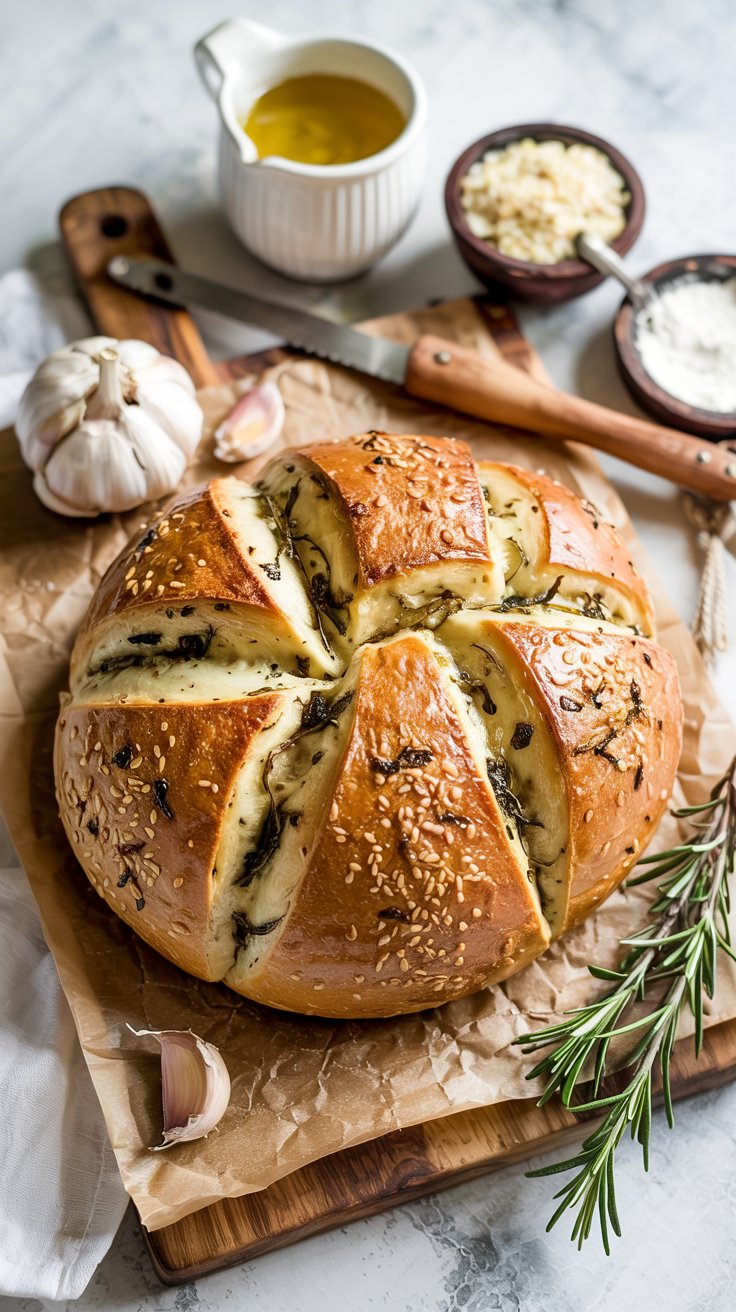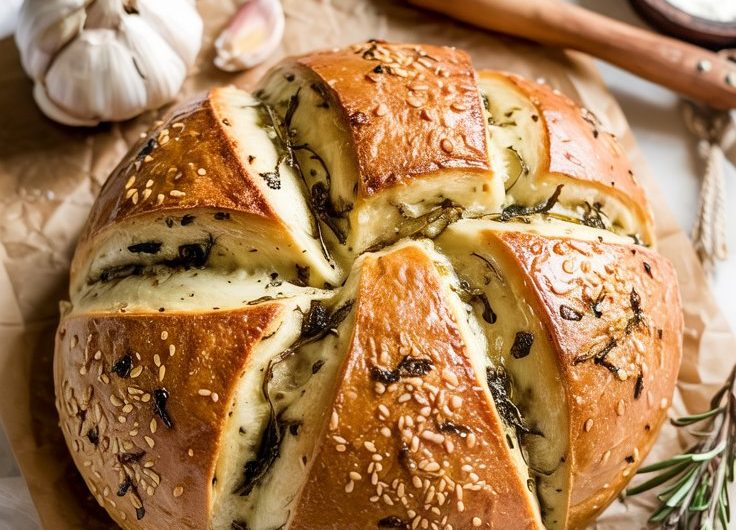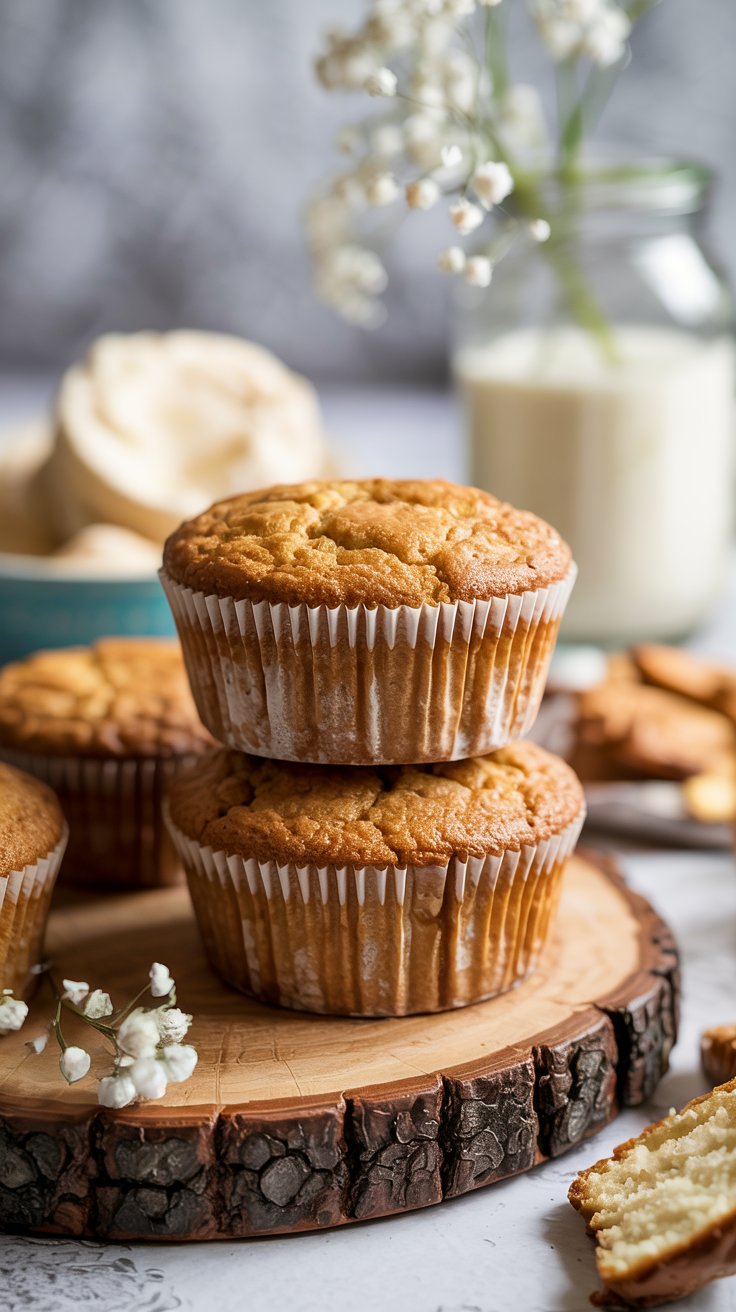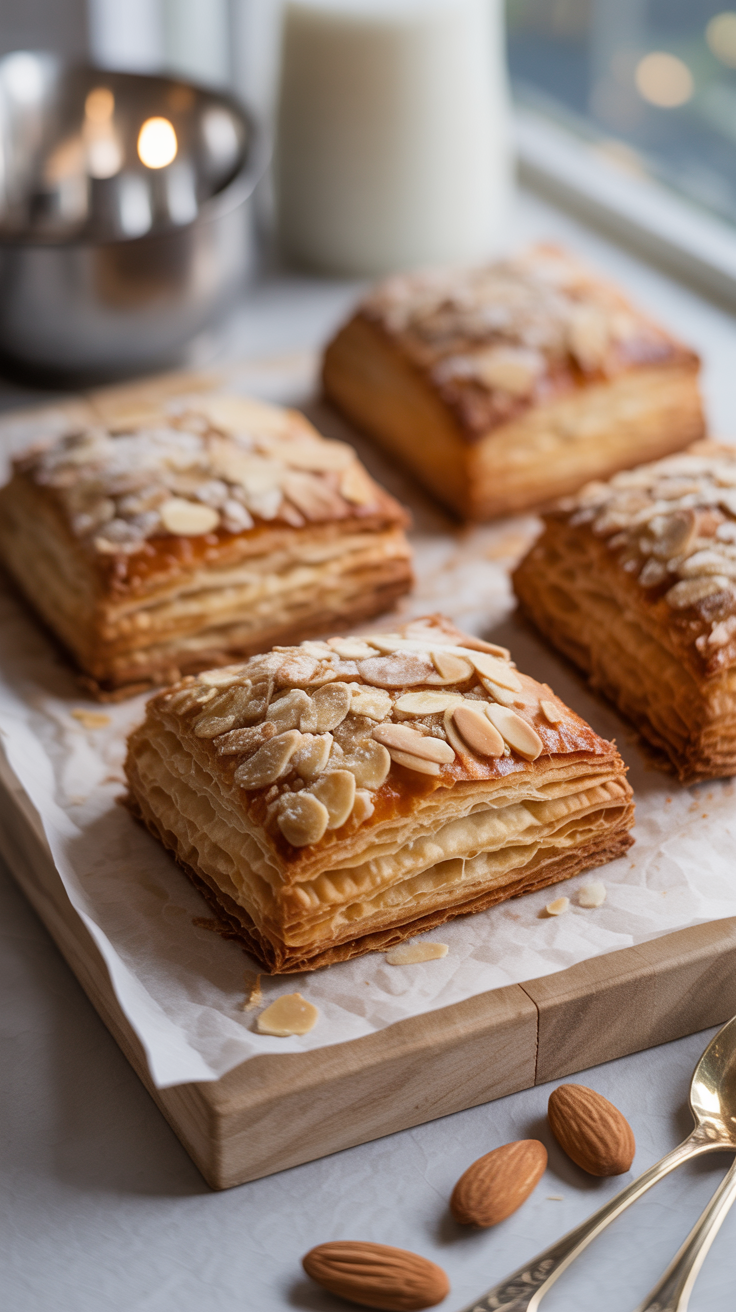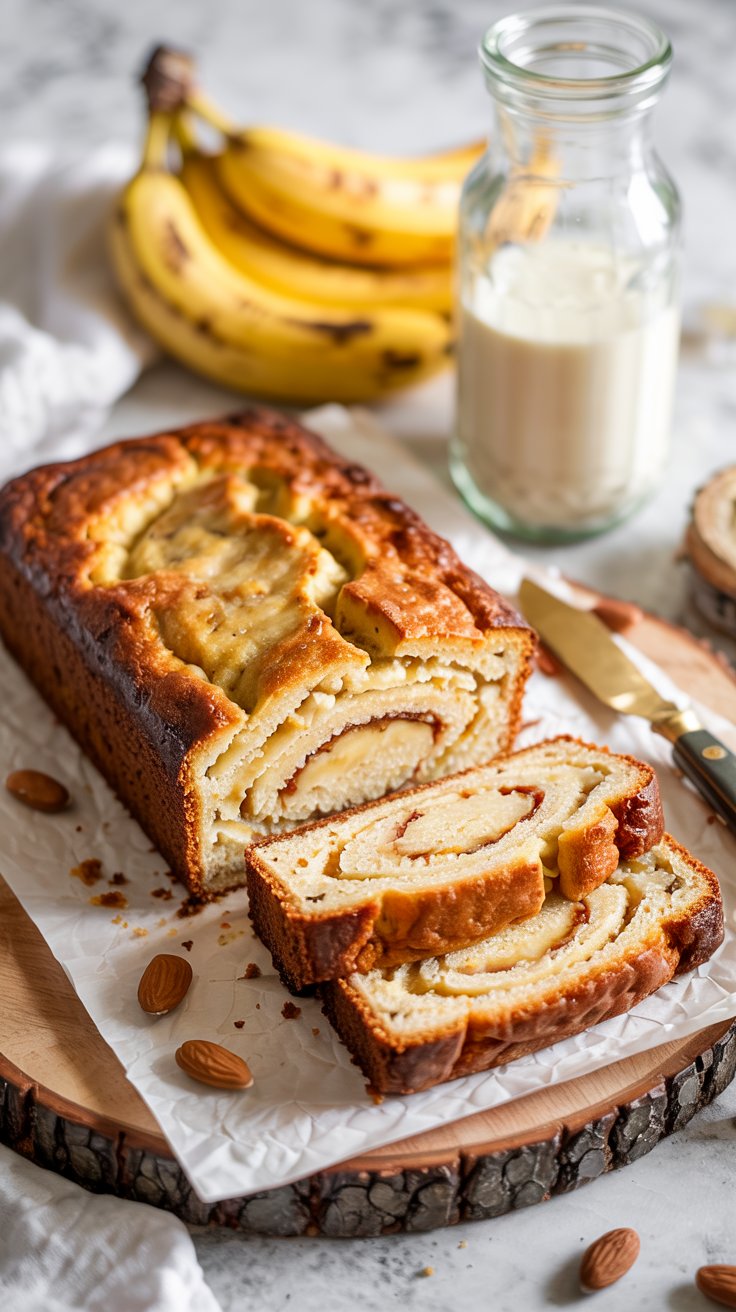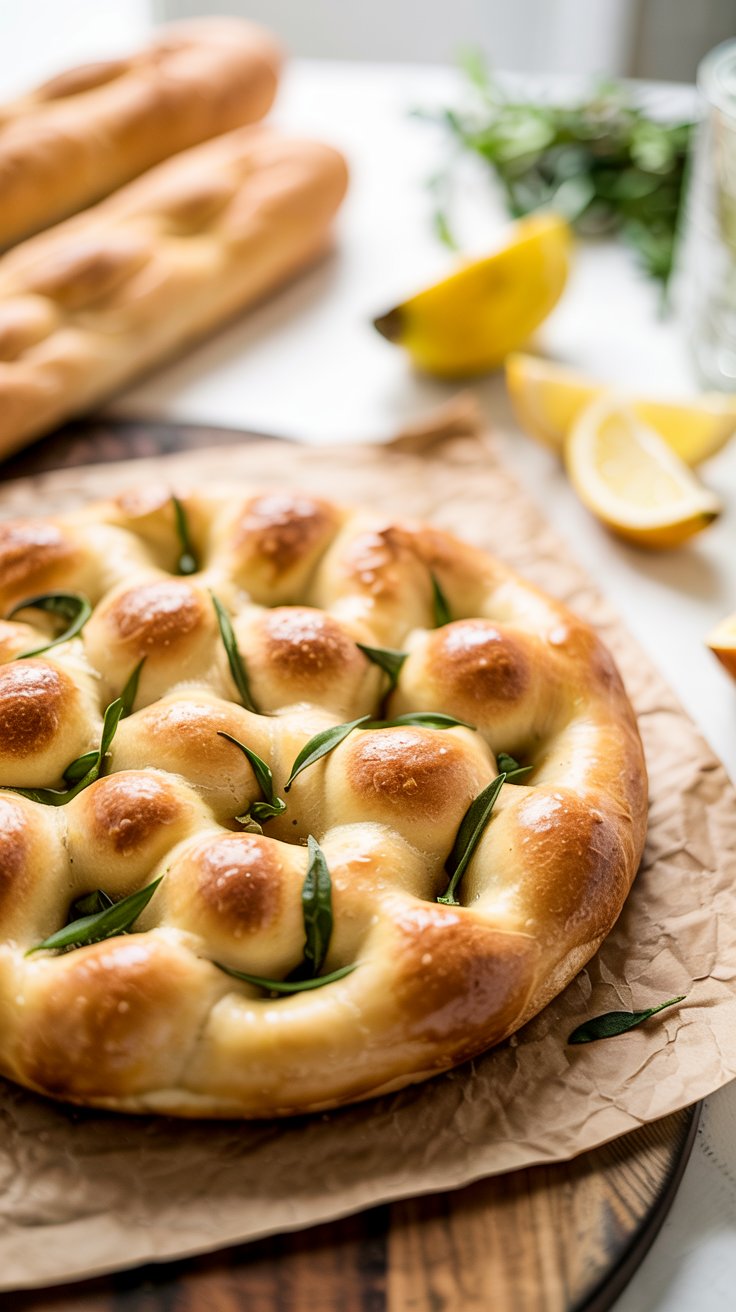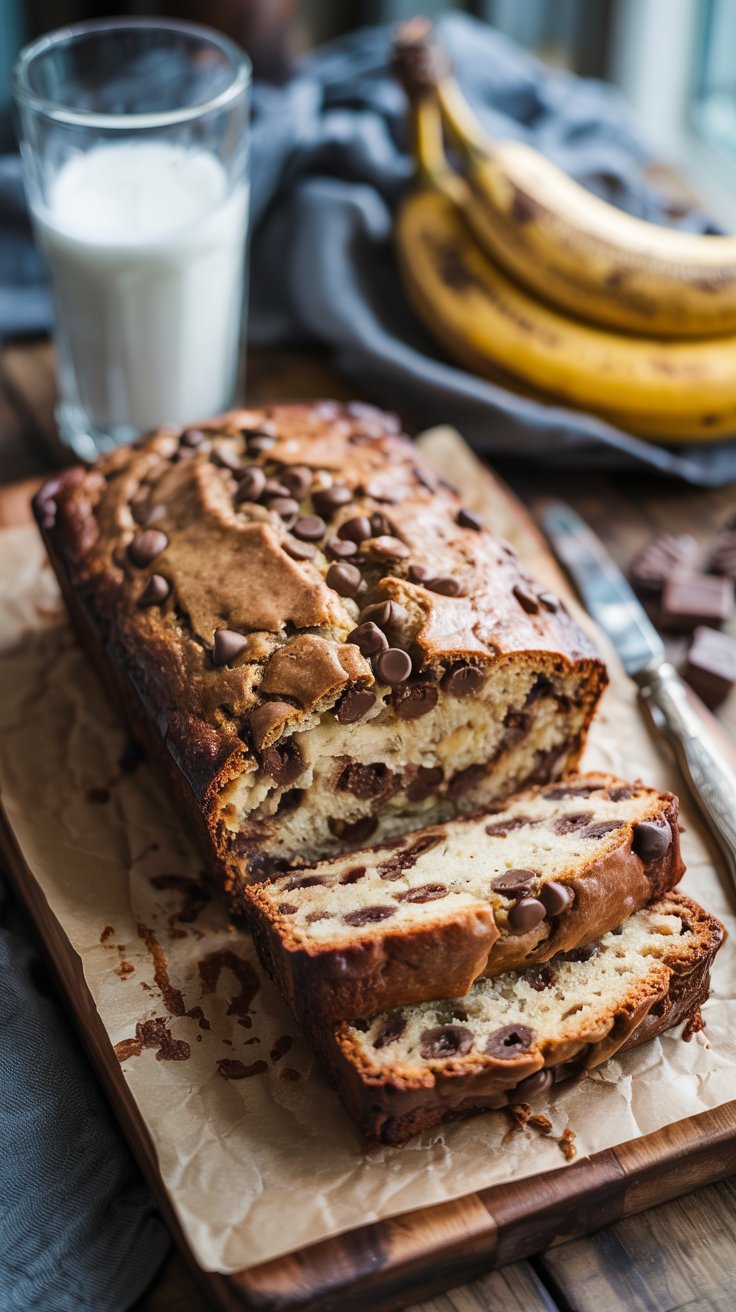No-Knead Roasted Garlic Rosemary Bread
No-Knead Roasted Garlic Rosemary Bread is a simple, slow-rise loaf with a thin crackly crust and a soft, fragrant crumb. Expect gentle garlic sweetness, fresh rosemary in every bite, and very little hands-on work. You mix, you wait, you bake. That is it. Below you will find the ingredients, the easy method, and a few practical tips so it comes out right the first time.
Ingredients for this No-Knead Roasted Garlic Rosemary Bread
- 1 whole bulb garlic
- 1 tablespoon olive oil, plus a little more for the foil
- 3 cups (360 g) bread flour or all-purpose flour
- 1 1/2 teaspoons fine sea salt
- 1/2 teaspoon instant yeast
- 1 1/2 cups (360 ml) room-temperature water, plus 1 to 2 tablespoons if needed
- 2 tablespoons fresh rosemary, finely chopped (or 1 teaspoon dried)
- Freshly ground black pepper, a few twists, optional
- Flour for dusting, and parchment paper
Instructions
- Roast the garlic: Heat the oven to 400°F (200°C). Slice off the top 1/4 inch of the garlic bulb to expose the cloves. Place on a small piece of foil, drizzle with about 1 teaspoon olive oil, wrap, and roast 35 to 40 minutes until the cloves are soft and golden. Let cool. Squeeze the cloves into a small bowl and mash with a fork. A tiny pinch of salt here brings it to life.
- Mix the dough: In a large bowl, whisk the flour, salt, and instant yeast. Add the water, the mashed roasted garlic, rosemary, and a little black pepper if using. Stir with a spoon until you get a shaggy, sticky dough. If there are lots of dry spots, splash in up to 2 tablespoons more water. It should look messy. That is perfect.
- First rise: Cover the bowl tightly with plastic wrap or a lid. Let it rest at room temperature for 12 to 18 hours. The dough will puff, spread, and be dotted with bubbles. When you jiggle the bowl, it should wobble a bit like a lazy jelly.
- Shape and second rest: Dust a piece of parchment and your hands with flour. Scrape the dough onto the parchment. Sprinkle a little more flour on top. Using your hands or a bench scraper, fold the edges toward the center a few times to make a rough ball. Flip seam side down. Cover loosely with a towel and let rest 30 to 45 minutes. It will relax and spread slightly.
- Preheat the pot: While the dough rests, place a Dutch oven with lid (4 to 5.5 quart) into your oven and heat to 450°F (232°C) for at least 30 minutes. This preheat helps create steam and that lovely crust.
- Bake: Lightly flour the top of the dough and, if you like, score it with a sharp knife or razor. Carefully remove the hot pot from the oven, lift the parchment with the dough, and lower it into the pot. Cover and bake 30 minutes. Uncover and bake 12 to 18 minutes more, until deep golden brown and the loaf sounds hollow when tapped. Internal temp should be around 205°F (96°C).
- Cool: Lift the bread out by the parchment and set on a rack. Let it cool at least 1 hour before slicing. I know, that crackle is tempting, but the crumb needs a moment to set. Make a cup of tea and enjoy the rosemary scent wandering through the kitchen.
Same-day option: If you are in a hurry, use 1 teaspoon instant yeast and warm water (about 100°F or 38°C). Let rise 3 to 4 hours until doubled and bubbly. Flavor will be a little milder but still good.
Cook and Prep Times
- Active prep: about 15 minutes
- Roasting garlic: 35 to 40 minutes (can be done ahead)
- First rise: 12 to 18 hours at room temperature
- Second rest: 30 to 45 minutes
- Bake: 42 to 50 minutes
- Total time: about 14 to 20 hours, mostly unattended
- Yield: 1 loaf, about 10 to 12 slices
Nutritional information
Approximate per slice, based on 12 slices:
- Calories: 120
- Carbohydrates: 23 to 25 g
- Protein: 4 g
- Fat: 1.5 to 2 g
- Fiber: 1 g
- Sodium: about 250 to 300 mg
These are estimates and will vary with flour type, exact slice size, and salt level.
Frequently asked questions
What if I do not have a Dutch oven?
No problem. Preheat a sturdy baking sheet or a cast-iron skillet. Slide the parchment and dough onto it, then cover the loaf with a large metal mixing bowl or an inverted roasting pan for the first 20 minutes to trap steam. Remove the cover and finish baking until golden. You can also use any oven-safe pot with a lid.
Can I use active dry yeast instead of instant?
Yes. Stir the active dry yeast into the water and let it sit 5 to 10 minutes until foamy, then mix with the dry ingredients. The rise times are similar. If your kitchen is cool, give it a bit more time until bubbly and puffy.
Can I swap in whole wheat flour?
You can replace up to 1 cup of the white flour with whole wheat. Add 1 to 2 tablespoons extra water if the dough feels stiff. The loaf will be a touch denser with a nuttier flavor, which pairs nicely with the roasted garlic.
No-Knead Roasted Garlic Rosemary Bread
1
raciones15
minutes42
minutes120
kcalNo-Knead Roasted Garlic Rosemary Bread is a simple, slow-rise loaf with a thin crackly crust and a soft, fragrant crumb. Expect gentle garlic sweetness, fresh rosemary in every bite, and very little hands-on work. You mix, you wait, you bake. That is it. Below you will find the ingredients, the easy method, and a few practical tips so it comes out right the first time.
Ingredients
1 whole bulb garlic
1 tablespoon olive oil, plus a little more for the foil
3 cups (360 g) bread flour or all-purpose flour
1 1/2 teaspoons fine sea salt
1/2 teaspoon instant yeast
1 1/2 cups (360 ml) room-temperature water, plus 1 to 2 tablespoons if needed
2 tablespoons fresh rosemary, finely chopped (or 1 teaspoon dried)
Freshly ground black pepper, a few twists, optional
Flour for dusting, and parchment paper
Directions
- Roast the garlic: Heat the oven to 400°F (200°C). Slice off the top 1/4 inch of the garlic bulb to expose the cloves. Place on a small piece of foil, drizzle with about 1 teaspoon olive oil, wrap, and roast 35 to 40 minutes until the cloves are soft and golden. Let cool. Squeeze the cloves into a small bowl and mash with a fork. A tiny pinch of salt here brings it to life.
- Mix the dough: In a large bowl, whisk the flour, salt, and instant yeast. Add the water, the mashed roasted garlic, rosemary, and a little black pepper if using. Stir with a spoon until you get a shaggy, sticky dough. If there are lots of dry spots, splash in up to 2 tablespoons more water. It should look messy. That is perfect.
- First rise: Cover the bowl tightly with plastic wrap or a lid. Let it rest at room temperature for 12 to 18 hours. The dough will puff, spread, and be dotted with bubbles. When you jiggle the bowl, it should wobble a bit like a lazy jelly.
- Shape and second rest: Dust a piece of parchment and your hands with flour. Scrape the dough onto the parchment. Sprinkle a little more flour on top. Using your hands or a bench scraper, fold the edges toward the center a few times to make a rough ball. Flip seam side down. Cover loosely with a towel and let rest 30 to 45 minutes. It will relax and spread slightly.
- Preheat the pot: While the dough rests, place a Dutch oven with lid (4 to 5.5 quart) into your oven and heat to 450°F (232°C) for at least 30 minutes. This preheat helps create steam and that lovely crust.
- Bake: Lightly flour the top of the dough and, if you like, score it with a sharp knife or razor. Carefully remove the hot pot from the oven, lift the parchment with the dough, and lower it into the pot. Cover and bake 30 minutes. Uncover and bake 12 to 18 minutes more, until deep golden brown and the loaf sounds hollow when tapped. Internal temp should be around 205°F (96°C).
- Cool: Lift the bread out by the parchment and set on a rack. Let it cool at least 1 hour before slicing. I know, that crackle is tempting, but the crumb needs a moment to set. Make a cup of tea and enjoy the rosemary scent wandering through the kitchen.
Notes
- Same-day option: If you are in a hurry, use 1 teaspoon instant yeast and warm water (about 100°F or 38°C). Let rise 3 to 4 hours until doubled and bubbly. Flavor will be a little milder but still good.

